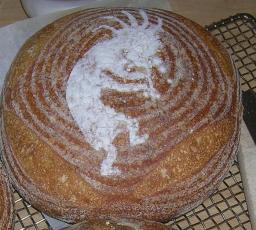I've found that the new year means I'm still going up the learning curve on my sourdough loaves. The continued low temperatures here in Kansas combined with above average barometric pressures gave me an opportunity to observe first hand some of the effects of weather on my starter and in the behavior of flours.
My starter exhibited the behavior that I should have expected with cooler room temperatures between 68-70F. Loaves rose more slowly, especially the loaf that had been retarded overnight. After refreshing my starter to a 1:2:2 ratio, activity was diminished, taking about 6 hours to double rather than the expected 3 1/2-4 hours.
I haven't lost my taste for loaves with whole wheat flour. I was surprised when my standby wheatMontana Bronze Chief turned my hydration estimates upside down. I usually aim for around 65-67% in loaves that have 500g total flour but the loaves turned out to appear much drier than 65% after kneading.

The crumb on this first enriched loaf wasn't as open as I'd like but the flavor was more than acceptable

My most recent loaf is a boule of Bauernbrot based on Salome's excellent formula where I used up the last 60g or so of rye from a bag, added more of the Bronze Chief, some AP and finished off with some bread flour. The dough was again on the dry side when kneading. Either my estimate of hydration was low or the rye and WW absorbed more than usual amounts of water. The outside temp was around 1F, barometric pressure was a very high 30.56. I did an overnight retarding after shaping and the loaf needed almost 4 hours to warm up for baking.

The crumb doesn't show up well in this picture either. The flavor is fine enough that my wife wants to take what's left up to Omaha for her parents to sample. Now I have a reason to look back through my recipes for a formula for a bread I haven't tried before.

I've got a plan for the next four weeks. First off, I'm going to build up my starters in two steps rather than one or just taking out 100g from the container I keep refrigerated and letting it warm up. Instead of 100g, I can use 150g because I have the time to experiment with the process. Hydration level is something to work on because this is the first winter I've used a starter. Dough hydration will be moving up to the high 60s or low 70s. I know I'll have to learn new techniques because plain kneading won't be enough to get the results I'm aiming for. It's back to the bench for me, there's work to be done in the flour patch.














